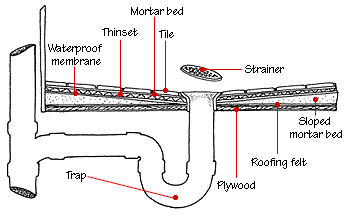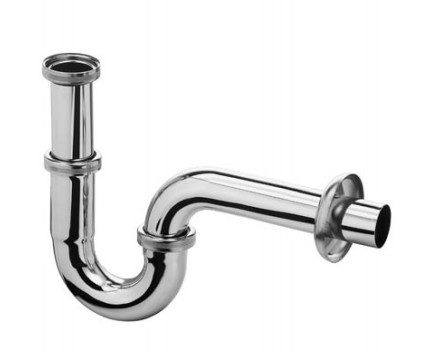Bathroom tubs and showers need to be vented to dislodge the water from the accrued space properly.
To properly vent the bathing station, you’ll need to make sure of a few things. We’re going to break down what venting is and what you need to know about a proper ventilation system from a fundamental standpoint.
Bathtubs need a vent to allow proper drainage and water displacement. Check with your state’s code if you install a bathtub with no vent, as it varies from state to state.
Depending on your state, your code may change on the plumbing and what needs to be done to stay within your venting code.
We properly advise you to get a second opinion from your local plumber on the code before starting any DIY projects to ensure that you fall within the code.
Let’s learn what a bathtub and shower vent is to identify them correctly.
What Is a Bathtub Vent?
A vent for your bathroom/shower is necessary for anything that catches water. It’s typically shaped with a curve or a “U” shape to catch items that fall down the drain.
We’re all humans and have things that go down the drain all the time, whether it be hair, loose items, or jewelry.
If we just had a single straight pipe, the pipe could get clogged and ruin our whole plumbing system. Often we’ll see draining systems that look like this:

This is a drawing by Home Tips to visualize how the draining and vent systems work.
As you can see, the sloped mortar bed and waterproof membrane are placed at an angle to make sure all the water leaks toward the strainer.
Commonly, we’ll see a shower pan (if the homeowner decides to use a pan instead of tiling) sit on top of the mortar bed.
Of course, if you’re in a tub, the tub will all drain toward the strainer, and the trap will ultimately catch everything.
The vent is how the water escapes once it has leaked off the user during a shower or once the lever is pulled during a bath. It’s important to know where the vent is and how it’s used.
For instance, it’s common to stand over the vent without knowing it, and the water can build up around your feet when taking a shower. Make sure the vent is clear and can absorb water on demand.
When taking a bath, the drain may get clogged with kid toys or any leftover items when you try to drain the water. As mentioned, be sure to clear all wrist and neck jewelry when taking a shower. This will keep the vent clear.
Why Bathtubs Need a Vent
To properly vent your bathtub, there needs to be a proper drainage system put in place; when looking at pictures of draining systems (similar to what we see above, we often see a “P-trap,” as it’s often referred to.
What Is A Bathroom Vent P-Trap?

The P-trap gets its name from the two 90-degree fixtures that resemble the letter P. The p-trap is innovative because of its multiple uses. Here are some of the uses we’ve identified from the p-trap.
- It traps debris and other items that will fall through the pipe
- Prevents deep clogging from either water or hair building up in the drain. A plumber can empty this trap if it happens to back up
- Stops sewer gasses from building up and coming through the drain. This can often be identified as a rusty rotten egg smell.
Pipes naturally get dirty because of the filth from our bodies and bacterial build-up. This is why the p-trap is shaped like it is. Gasses accrue in the drain pipe, and due to its shape, they will sit in the pipe and not travel north through the pipe.
Most codes mandate that some p-trap be installed in the plumbing. Again, we strongly recommend you consult with your local plumber and see if a p-trap is necessary for the ventilation process.
How To Fix A Bathtub That Won’t Drain
Clogs can happen from time to time. Our goal is to make sure we have the cleanest pipes to prevent further damage to our system.
It’s crucial to make sure you’re proactive in cleaning your pipes rather than reactive. Take the initiative to clean your pipes and ensure that you’re flushing the pipes with the proper cleaner each week or month.
Add Boiling Hot Water Down The Drain
The first option is to use boiling water. The boiling water will help heat the residue stuck on the bottom of the trap and hopefully melt it away.
The boiling hot water should then naturally go down the drain as regular water.
If the drain is completely clogged, we caution you to be careful with the hot water as it may spit back at you if it is completely clogged.
Baking Soda & Vinegar
This is the natural alternative to using chemicals in bathtubs, such as bleach or other harmful chemicals.
Add baking soda & vinegar down the drain and let the chemical process go to work. This should also melt away or create clearance for your drain.
Take Off The Strainer
If the water and liquid solution didn’t work, we might have to get our hands dirty. Detach the strainer, and put your hands down the drain.
If you do not want to use your hands, find something long and skinny to put down the drain to fish out the content.
Be careful not to scratch or crack the pipe with whatever you put down the drain.
Call A Plumber
This, of course, is the last option for anyone, as we try to save as much money as possible. However, this is the best option out of all of the options listed above.
This will ensure that your plumbing is done correctly and that no mistakes are made due to inexperience.
Conclusion
Make sure your bathtubs and showers are adequately vented based on the code of your state. When in doubt, consult with a plumber by making a simple phone call, which is more than likely free of charge.
Plumbing can be expensive and time-consuming, so every step toward fixing your plumbing must be done correctly. You do not want to damage or harm your bathroom vanity.
We’ve compiled a complete list of frequently asked bathroom questions for new and experienced homeowners.
Our team of experts answers these questions to help assist you through DIY projects and home repairs.

For over a decade, Robin has been a real estate agent, interior design specialist, and mother. Through her trials and tribulations, she wanted to create the perfect website to help you save money and make your home look beautiful.
